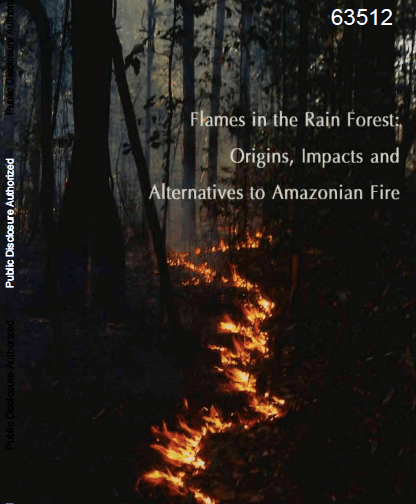Flames in the rain forest: Origins, impacts, and alternatives to Amazonian fires
$20.09
Unknown Binding – January 1, 1999
by Daniel C Nepstad (Author)
- Estimated delivery time 2-8 days
-
Shipping rates are calculated based on local US cities; international rates may apply for other countries.
Customers Reviews
Related products
Amazonian Floodplain Forests: Ecophysiology, Biodiversity and Sustainable Management (Ecological Studies, 210)
2011th Edition
by Wolfgang J. Junk (Editor), Maria T. F. Piedade (Editor), Florian Wittmann (Editor), Jochen Schöngart (Editor), Pia Parolin (Editor)
Central Amazonian floodplain forests are an unique and endangered ecosystem. The forests grow in areas that are annually flooded by large rivers during mean periods of up to 8 months and at depths of up to 10 m. Despite this severe stress, these forests consist of over 1,000 species and are by far the most species-rich floodplain forests worldwide. The trees show a broad range of morphological, anatomical, physiological, and phenological adaptations that enable them not only to survive the adverse environmental conditions, but also to produce large amounts of biomass when the nutrient levels in water and soils are sufficiently high. This is the case in the floodplains of white-water rivers, which are used for fisheries, agriculture, and cattle-ranching but which also have a high potential for the production of timber and non-timber products, when adequately managed. Latest research on ecophysiology gives insight how tree species adapt to the oscillating flood-pulse focusing on their photosynthesis, respiration, sap flow, biochemistry, phenology, wood and leave anatomy, root morphology and functioning, fruit chemistry, seed germination, seedling establishment, nitrogen fixation and genetic variability. Based on tree ages, lifetime growth rates and net primary production, new concepts are developed to improve the sustainability of traditional forest managements in the background of an integrated natural resource management. This is the first integrative book on the functioning and ecologically oriented use of floodplain forests in the tropics and sub-tropics.It provides fundamental knowledge for scientist, students, foresters and other professionals on their distribution, evolution and phytogeography. “This book is an excellent testimony to the interdisciplinary collaboration of a group of very dedicated scientists to unravel the functioning of the Amazonian Floodplain forests. They have brought together a highly valuable contribution on the distribution, ecology, primary production, ecophysiology, typology, biodiversity, and human use of these forests offering recommendations for sustainable management and future projects in science and development of these unique wetland ecosystems. It lays a solid scientific foundation for wetland ecologists, foresters, environmentalists, wetland managers, and all those interested in sustainable management in the tropics and subtropics.” Brij Gopal, Executive Vice President International Society for Limnology (SIL).
Lamto: Structure, Functioning, and Dynamics of a Savanna Ecosystem (Ecological Studies, 179)
2006th Edition
by Luc Abbadie (Editor), Jaques Gignoux (Editor), Xavier Roux (Editor), Michel Lepage (Editor)
Synthesizing 40 years of ongoing ecological research, this book examines the structure, function, and dynamics of the Lamto humid savanna. From the history of the Lamto ecology station, to an overview of enivronmental conditions of the site, and examining the integrative view of energy and nutrient fluxes relative to the dynamics of the region's vegetation, this exacting work is as unique and treasured as Lamto itself.
Tropical Forests and Global Atmospheric Change
1st Edition
by Yadvinder Malhi (Editor), Oliver Phillips (Editor)
Tropical forests represent the world's most biodiverse ecosystems and play a key role in hydrology, carbon storage and exchange. Many of the human-induced pressures these regions are facing, e.g. fragmentation and deforestation, have been widely reported and well documented. However, there have been surprisingly few efforts to synthesize cutting-edge science in the area of tropical forest interaction with atmospheric change. At a time when our global atmosphere is undergoing a period of rapid change, both in terms of climate and in the cycling of essential elements such as carbon and nitrogen, a thorough and up-to-date analysis is now timely. This research level text, suitable for graduate level students as well as professional researchers in plant ecology, tropical forestry, climate change science, and conservation biology, explores the vigorous contemporary debate as to how rapidly tropical forests may be affected by atmospheric change, and what this may mean for their future.
Australian Rainforests: Islands of Green in a Land of Fire
Illustrated Edition, Kindle Edition
by D. M. J. S. Bowman (Author) Format: Kindle Edition
Why do Australian rainforests occur as islands within the vast tracts of Eucalyptus? Why is fire a critical ecological factor in every Australian landscape? What were the consequences of the ice-age colonists use of fire? In this original and challenging book, David Bowman critically examines hypotheses that have been advanced to answer these questions. He demonstrates that fire is the most critical factor in controlling the distribution of rainforest throughout Australia. Furthermore, while Aboriginal people used fire to skilfully manage and preserve habitats, he concludes that they did not significantly influence the evolution of Australia's unique flora and fauna. This book is a comprehensive overview of the diverse literature that attempts to solve the puzzle of the archipelago of rainforest habitats in Australia. It is essential reading for all ecologists, foresters, conservation biologists, and others interested in the biogeography and ecology of Australian rainforests.
Land-Use Change Impacts on Soil Processes: Tropical and Savannah Ecosystems
Kindle Edition
by F.Q. Brearley (Author, Editor), A.D. Thomas (Author, Editor) Format: Kindle Edition'
This book examines the effects that land-use changes (notably agricultural intensification, logging, soil erosion, urbanisation and mining) have on soil characteristics and processes in tropical and savannah environments. It covers a range of geographical regions and environments as impacts of land use change are often site specific. The effects of land use change on various aspects of the soil ecosystem from both a chemical and biological perspective will be examined.
Tropical Forest Ecology: The Basis for Conservation and Management (Tropical Forestry)
2005th Edition
by Florencia Montagnini (Author), Carl F. Jordan (Author)









There are no reviews yet.